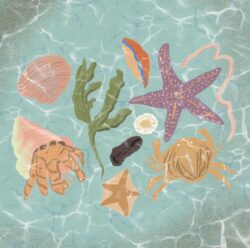Nature is all around us; from the mountains to the oceans, Santa Barbara offers a vast array of wildlife that invites exploration. Down the wooden stairs on the outskirts of Isla Vista, Devereux Beach is a popular destination for dog walkers, surfers, sunset enjoyers and more. Attention typically gravitates toward the breathtaking views of the landscape and horizon — however, when you look closer at the rocks you’re standing on, you’ll find a whole miniature world just beneath you.
Tide pooling is a great activity to enjoy alone or with friends and a cost effective way to observe nature up close. I went exploring tide pools at Devereux Beach, often referred to as “Devs,” accompanied by the UC Santa Barbara Scuba Club. The club meets at sunset to explore and learn about tide pool creatures and is open for anyone to join.
Last week, between Nov. 5 and 7, a King Tide transformed Devs into a bustling tourist destination. As the moon’s movement and gravitational pull affects the sea level, the height of the tide varies throughout the day. The amount of variance changes throughout the year. A “King Tide” occurs when the Earth is closest to the sun, creating the largest variation between high and low tide. While tide pooling is a year-round activity, this phenomenon enables the greatest visibility of pools and their abundance of wildlife. The next King Tide will occur between Dec. 4 and 6, so mark your calendars for your next tide pooling excursion!
Tide pools are their own ecosystem between the ocean and the sand. As the waves roll in and out, ocean water and its inhabitants get left behind in the crevices of rocks. The creatures that live here — mollusks, crustaceans, and echinoderms, for example — face extreme living conditions, such as exposure to extreme sunlight and rapid currents, varying salinity (salt levels), temperature fluctuations, oxygen depletion and more.
As you approach the Devs pools, the first creature you might spot — and the most abundant to the naked eye — is a sea anemone. These animals are invertebrates, and while they have no face, their body mostly consists of a range of tentacles and a gastrovascular cavity, also known as a mouth. You might also notice they are often covered in tiny rocks and bits of seashells. This not only acts as a mechanism of camouflage but also to shield them from the sun’s heat rays so they don’t dry out.
We met a local while exploring who came prepared with an ultra-violet flash light. By evening it was dark out, and when shined onto the sea anemones they glowed an intense green. This is because of biofluorescence, a process where molecules of antioxidant proteins can absorb UV light from the sun during the day and re-emit it at night.

Another common creature to find are crabs, who are much more mobile, making use of their eight hind legs and two giant claws. We encountered two crabs battling each other and even found the remains of a freshly snipped claw laying on the rocks. Rock crabs are fierce creatures and get competitive over territory, food and mates. Luckily for this rock crab, they have the ability to regenerate severed limbs, a function called molting.
As long as you’re cautious of the safety of the crab and yourself, you can gently pick them up by their hind legs to examine them up close. One can even tell the gender of the crustacean by flipping over its bottom side. Females have a curved “U-shaped” abdomen, whereas males have a sharper “T-shape.” In doing so, we discovered the two crabs fighting were both male.
Not all creatures are found on the surface of the pools — many hide deeper in the wedges and can only be revealed by rolling up your sleeves and observing closely. When we carefully lifted up a rock, a small tentacle reached out, and we found a baby octopus. Octopuses are very flexible creatures and can squeeze into any hole their beak can fit in.
Also underneath and along the edges of rocks are many types of sea stars, more rare and elusive creatures. We were able to find both ochre stars and brittle stars. The ochre stars are the bigger sea stars you can find. Typically only a few near each other, making them easier to spot. Brittle stars are smaller and blend in easier, and we spotted hundreds of them convening in a washed up kelp bush.
Finally, my favorite creature I spotted that took me multiple trips to Devs to find is a nudibranch. Nudibranchs are the slugs of the ocean who come in a vast array of bright neon colors and whimsical shapes. They are not much bigger than a quarter, but they are poisonous and obtain their stinging cells by feeding on other poisonous creatures.
Devereux Beach is a great place to visit if you are looking to explore an accessible and active habitat. The key in spotting these tide pool creatures is patience, as they are good at hiding but make the hunt to spot them even more thrilling. There are thousands of species to find beyond this list, so grab your flashlight, roll up your pants and make your way through the rocks for an awesome adventure!




















